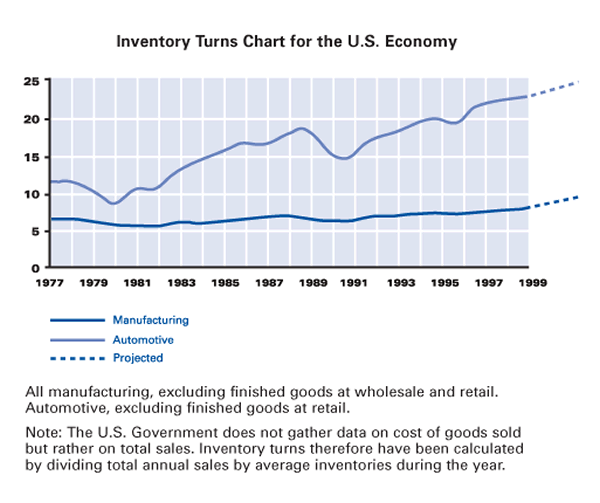Inventory Turns
A measure of how quickly materials are moving through a facility or through an entire value stream, calculated by dividing some measure of cost of goods by the amount of inventory on hand.
Probably the most common method of calculating inventory turns is to use the annual cost of goods sold (before adding overhead for selling and administrative costs) as the numerator divided by the average inventories on hand during the year. Thus:
| Inventory turns = | Annual cost of goods sold |
| Average value of inventories during the year |
Using the cost of goods rather than sales revenues removes one source of variation unrelated to the performance of the production system—fluctuations in selling prices due to market conditions. Using an annual average of inventories rather than an end-of-the-year figure removes another source of variation—an artificial drop in inventories at the end of the year as managers try to show good numbers.
Inventory turns can be calculated for material flows through value streams of any length. However, in making comparisons remember that turns will decline with the length of the value stream, even if performance is equally “lean” all along the value stream. For example, a plant performing only assembly may have turns of 100 or more but when the parts plants supplying the assembly plant are added to the calculation, turns often will fall to 12 or fewer. And if materials are included all the way back to their initial conversion—steel, glass, resins, etc.—turns often will fall to four or fewer. This is because the cost of goods sold at the most downstream step doesn’t change but the amount of materials in inventories grows steadily as we add more and more facilities to our calculation.
Inventory turns are a great measure of a lean transformation if the focus is shifted from the absolute number of turns at each facility or in the entire value stream to the rate of increase in turns. Indeed, if turns are calculated accurately using annualized averages of inventories, they can be “the one statistic that can’t lie.”
Although most companies measure inventory using inventory turns, the Building a Lean Fulfillment Stream workbook makes the point of using Average Days on Hand (ADOH) instead. ADOH represents inventory as how many days a process could sustain activity by consuming its stored inventory. An advantage of ADOH is that it lets managers visualize how much inventory they have relative to a day’s activity. For example, if a supplied item has an order-to-delivery lead time of four days, but 20 days are on hand, it’s easy to see that there is five times as much inventory as needed.
